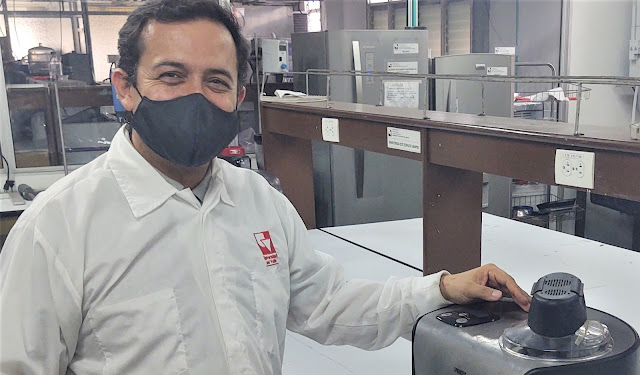The big challenge, says Dr Juan Sebastián Ramírez-Navas, a professor of the GIPAB research group at Univalle, is that when you add alcohol to the mixture, the ice cream is much more difficult to freeze, requiring temperatures of up to 18 degrees celcius below zero.
"That's why we have to look for a mixture of stabilizers that raise this freezing point to something that is closer to normal ice cream, about four degrees below zero," said Professor Ramirez-Navas.
According to a market report, the size of the alcoholic ice cream market was valued at $1.29 billion USD in 2021 and Alcoholic Ice Cream total revenue is expected to grow by 7.2% between 2022 and 2027.
For this reason, the Univalle researchers hope that a private sector company can collaborate to produce ice cream with liquor on an industrial scale.
 |
| Photo: Samples of ice cream with liquor. Credit: Andrew James/NCC-FI/Univalle |
How do you make alcoholic ice cream?
In the lab at Univalle's school of food engineering, Campo and Rojas show off the ice cream machine they used—just like one suitable for home use—and explain how they made the high-quality ice cream for their experiments.
Dry ingredients like milk powder were mixed with vanilla flavor, water, stabilizers and glucose before pasteurization (which removes potentially bad microorganisms from the mix).
Before entering the freezer, there are a few hours of maturation, where the mixture is homogenized, that is, the ingredients are equally distributed within the mixture.
Campo and Rojas explained that the other challenge, more than the freezing point, is how alcohol can be encapsulated within the molecular network of ice cream, thus avoiding phase separation due to its different freezing points.
The key to industrial-scale ice cream is finding the most optimal stabilizer ratios that produce the best mix.
The researchers tested a mixture of three stabilizers: Methyl cellulose, known as a source of fiber; Guar gum, a key thickening agent to capture alcohol; and Carrageenan, from red seaweed.
Rojas explained that the liquor they used was Triple Sec, which doesn't have a strong flavor and resulted in an ice cream with an alcohol concentration of around 13%.
"To eat ice cream like this is similar to having a cocktail," Rojas said.
The researchers said they were lucky enough to finish all their work in the lab in February 2020, just days before the start of the global pandemic shutdown of the university.
“We wrote fast and we presented it in September 2020,” Rojas said.
Read more from the School of Food Engineering: Univalle Researchers Developing Exotic Fruit Extractions to Add Value for Farmers
 |
| Photo: Professor Juan Sebastian Ramírez-Navas Credit: Andrew James/NCC-FI/Univalle |
Factory for Ice cream scientists
While making ice cream for science sounds like fun, it's also a great way to train future food engineering professionals.Professor Ramirez-Navas teaches the course "Principles of Engineering" applied to dairy products. Several students who have taken this course have done their graduate projects on topics related to dairy, such as cheese or caramelized milk. However, a few years ago, the professor began a line of research on the subject of ice cream, opening an interesting area of work for his students.
“It is an excellent subject to train food engineers: by studying ice cream, future engineers learn the principles of research and development and innovation in the field of food, design of experiments, design of mixtures, physical properties, parameters of quality, sensory evaluation, among many other topics,” Professor Ramirez-Navas said.
Grade students also think that ice cream is an accessible topic.
"Ice cream is a very good topic, more to be done real than the previous thing was only theoretical... all the problems that arise, we solve them on our own," Campo said, adding that it is also easy to explain her work to his family.
“My family really likes to eat ice cream and they were happy to try samples of my work,” Campo said.

Comentarios
Publicar un comentario